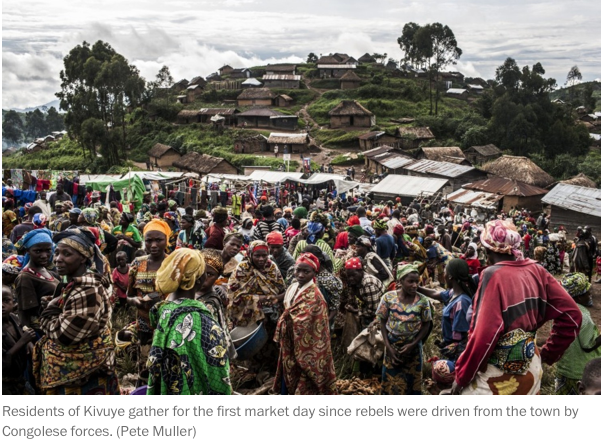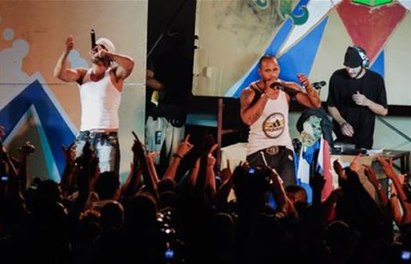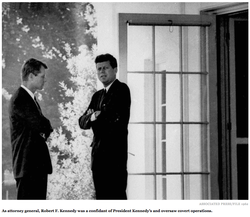
By Sudarsan Raghavan December 29 at 3:30 AM
CLICK HERE TO READ THIS ARTICLE ON THE WASHINGTON POST WEBSITE
KIVUYE, Congo -- The Rwandan militia commander showed up moments after I arrived in this village deep in the eastern Congo. He was barely more than a teenager, a youth in lizard-colored fatigues and cap affixed with a red star, clutching a walkie-talkie. But he was called Major Hamza. And his authority was clear. He demanded to know who I was.
Bernard Kamanzi, the top government official in Kivuye, mumbled: I was an American journalist. He waited nervously as Major Hamza digested this information. Then, without a word, the commander turned and left the hut.
“The FDLR now controls the village,” explained Kamanzi, referring to the Rwandan ethnic Hutu militia that has plagued this country for years.
Earlier this year, I had spent a few months in this hill-top hamlet chronicling how Africa’s deadliest war was playing out two decades after Rwanda’s genocide spilled over into Congo. Back then, a merciless warlord had just fled Kivuye after months of terrorizing the community. The villagers -- impoverished farmers living in plywood shacks, and displaced people in nearby camps -- continued to suffer in many ways. But there was a sense of hope.
Last month, I returned to see what had happened since then. It was soon clear that the villagers’ lives, once again, were ordered by men with guns.
[Related Story: In Congo, trapped in violence and forgotten]
In the two decades I’ve crisscrossed sub-Saharan Africa, mostly writing about conflict and misery, I have never seen a country as maddeningly frustrating as the Democratic Republic of Congo. With vast quantities of gold, diamonds and copper, and lakes and rivers to hydropower up the continent, it should have been Africa’s economic engine – not one of its poorest and most hopeless corners. Today, it’s a cautionary tale of how conflict, graft and poor governance strangle a society.
The last time I felt hope for Congo was in the 1990s. I followed rebel leader Laurent Kabila and his army in 1997 as they traveled on foot through thick jungles, in rickety canoes, and on rusting planes to reach the capital Kinshasa, where they overthrew the corrupt U.S.-backed dictator Mobutu Sese Seko. But Kabila ultimately proved little different from his predecessors. And over the years, I would meet new populations of scarred Congolese, their lives broken by a succession of conflicts.
As I walked around Kivuye this time, I was searching for even a sliver of optimism in Congo’s depressing narrative. But in my heart I knew it would be difficult to find.
Back in the spring I had spent days at the village's ill-equipped health clinic. There were no doctors, and it had been two years since the four nurses were paid. Now, as 2014 came to a close, the situation was even worse: the head nurse, Augustin Bazamanga, had resigned. Medicine shortages had deepened. A pass-the-cup effort around the village to raise funds for the clinic had failed to produce enough money.
Then there was Nyiramana Nzabomimpa, a villager I met in March. She had been forced back then to carry her severely malnourished 2-year-old child, Sifwe, on an eight-hour walk to the nearest hospital for treatment. The toddler nearly died on the journey. On this latest visit, I learned that Nzabomimpa had hiked to the hospital again, this time bearing the little girl’s sick twin, Rachel.
When I found them at the hospital, in the town of Mweso, Rachel was on the brink of death, her flesh peeling from malnutrition. Her mother told me that Sifwe, too, was showing signs of malnutrition again, but Rachel’s condition was more severe. “I couldn’t carry them both,” she explained, as she held Rachel on a hospital bed.
The doctor assured me Rachel would survive, and for a moment I felt happiness.
But later I saw Eugenie Shamdwe, a rape counselor in the town of Kitchanga. She had treated over a dozen women in April, several of whom told me in excruciating detail how they were gang-raped by Congolese army soldiers near Kivuye. Afterwards, U.N. monitors also interviewed the women. Since then, however, none of the perpetrators have faced trial or questioning.
“This is what usually happens in Congo,” said Shamdwe.
Meanwhile, the Ebola crisis in West Africa has taken an unexpected toll here. The aid agency Doctors Without Borders wanted to expand its presence in this area, but found itself with a shortage of physicians because of the needs in Liberia and Sierra Leone, said Ellen van der Velden, the agency’s chief in North Kivu province.
Ultimately, I found a silver lining in the most unexpected source: Kivuye’s new rulers.
The United States has designated the FDLR -- the French acronym for the Democratic Forces for the Liberation of Rwanda – a terrorist entity, because of its record of committing rape, torture and other atrocities. Some of its leaders helped perpetrate the genocide in Rwanda two decades ago.
In Kivuye, though, the militia keeps a low profile. Unlike other groups of fighters, its members don’t impose taxes or beat residents, though they conduct patrols and force Kamanzi to provide intelligence on U.N. and Congolese army movements. And the militia is protecting the village from one of the most brutal warlords who ever ruled over it, Kasongo Kalomo. The FDLR militiamen now consider him an enemy -- because they believe neighboring Rwanda is bankrolling him to fight them. They will prevent him from seizing Kivuye again.
But the village still faces the threat of war.
Col. Bigirabagabo, the warlord who last traumatized Kivuye, remains at large, connected to well-armed regional militias. Then there is Kasongo, who still exerts power in the region. I found him at his family’s wooden shack outside the town of Kashuga. He lives in plain sight, off a main road, his fighters nearby. U.N. peacekeepers, known by the French acronym MONUSCO, and the Congolese army know where he lives.
“The FDLR wants to create problems,” said Kasongo menacingly. “The Congolese people are tired of them. If MONUSCO can’t stop them, I will.”
The U.N. Security Council has issued an ultimatum to the FDLR fighters to lay down their weapons by January – or face a military onslaught by a U.N. peacekeeper combat force.
“The environment remains volatile,” said Capt. Oscar Marquez, the Uruguayan company commander of U.N. peacekeepers based in the town of Kitchanga.
He could have been describing any patch of the eastern Congo.
As I left Kivuye, I wondered if this is as good as it gets. With U.N. forces stretched thin, and unable to adequately protect civilians, and with the government largely absent, is the best an eastern Congo village can hope for is rule by an armed group that doesn’t brutalize them?
The residents of Kivuye expect even this gain to vanish. They worry that they will be trapped in the cross fire if the FDLR doesn’t meet the January deadline and the United Nations follows through on its threats. “Bullets don’t choose if you are Congolese or Rwandan,” said Kamanzi.
Sudarsan Raghavan has been The Post's Kabul bureau chief since 2014. He was previously based in Nairobi and Baghdad for the Post.



 RSS Feed
RSS Feed
